
|
Around 6.0 mag in early March, still visible with a naked eye. Moderate size of 15 arcmin, and moderately condensed as DC=5. Fading slowly. It is very near by Polaris, and it is visible all night in the Northern Hemisphere. In the Northern Hemisphere, it keeps observable in good condition for a long time while the comet is bright enough visible visually until October when it becomes faint as 14 mag.
Date(TT) R.A. (2000) Decl. Delta r Elong. m1 Best Time(A, h)
Mar. 5 5 2.99 83 58.4 0.815 1.349 96 5.9 19:22 (178, 41)
Mar. 12 7 36.28 84 48.3 0.886 1.400 96 6.2 20:27 (180, 40)
|
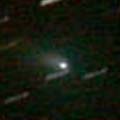
|
Brightening rapidly. In January when it was visible in the Northern Hemisphere, it was an 11 mag small object. However, after it has gone to the southern sky, a very large appearance, 9.2 mag and 8 arcmin, was observed on Feb. 14 (David Seargent). Now it is so bright as 8.1 mag, bright enough to be visible with binoculars (Mar. 5, Michael Mattiazzo). In the Southern Hemisphere, it keeps visible as bright as 8 mag until April, although it locates low after late March. In the Northern Hemisphere, it is not observable until June when it appears in the morning at 12.5 mag.
Date(TT) R.A. (2000) Decl. Delta r Elong. m1 Best Time(A, h)
Mar. 5 21 28.85 -80 30.6 0.815 1.111 75 8.3 5:00 (349,-33)
Mar. 12 0 19.87 -70 49.7 0.869 1.046 67 8.1 19:28 ( 24,-35)
|
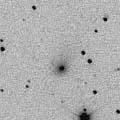
|
The brightening evolution had been slower than a typical comet since its discovery until February. However, it suddenly became bright and large in March. It was small as 10.3 mag and 1.9 arcmin on Feb. 5, but transfigured dramatically within one month as 7.8 mag and 6 arcmin on Mar. 8 (Seiichi Yoshida). In the Northern Hemisphere, it will be unobservable in early April. In the Southern Hemisphere, it will appear in the morning low sky in mid March, then it keeps observable after that. It keeps bright as around 8 mag from March to May. Reinder J. Bouma pointed out that the slow brightening is similar to C/1999 S4 or C/2002 O7. The current rapid brightening may be a sign of something?
Date(TT) R.A. (2000) Decl. Delta r Elong. m1 Best Time(A, h)
Mar. 5 20 36.75 9 56.1 1.548 1.009 39 9.0 5:00 (272, 21)
Mar. 12 20 53.64 5 35.2 1.467 0.947 39 8.7 4:51 (276, 19)
|

|
It is 9.9 mag with a diameter of about 4 arcmin (Mar. 7, Juan Jose Gonzalez), brighter than this ephemeris. It will be fading gradually in the evening sky, but maybe the fading is slower than predicted. However, it is very diffused now, so it is not easy to see it. It becomes too low in the evening sky at 12-13 mag in April.
Date(TT) R.A. (2000) Decl. Delta r Elong. m1 Best Time(A, h)
Mar. 5 3 31.46 -18 7.0 2.609 2.392 66 10.9 19:22 ( 43, 24)
Mar. 12 3 32.71 -15 56.2 2.795 2.475 61 11.2 19:28 ( 51, 21)
|
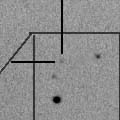
|
The condition of this return is bad. It is not observable around the perihelion passage. It will appear at dawn in July at 14.5 mag, then it will be fading after that.
Date(TT) R.A. (2000) Decl. Delta r Elong. m1 Best Time(A, h)
Mar. 5 22 26.10 -13 27.3 2.397 1.439 11 11.9 5:00 (276,-15)
Mar. 12 22 48.56 -11 50.7 2.401 1.451 13 12.0 4:51 (274,-15)
|

|
The brightening evolution has been much slower than expected. It was not visible visually still in February, fainter than 13.9 mag (Feb. 5, Seiichi Yoshida). But it finally began to be visible visually at 13.3 mag in March (Mar. 1, Juan Jose Gonzalez). Now it is 12.7 mag (Mar. 8, Seiichi Yoshida). It is small, but rather well condensed, so easy to see. If it will brighten as expected after this, it will reach to 9 mag in spring and summer. It may become a naked-eye object due to the Deep Impact mission on July 4.
Date(TT) R.A. (2000) Decl. Delta r Elong. m1 Best Time(A, h)
Mar. 5 13 29.61 10 41.4 1.022 1.912 143 12.6 2:39 ( 0, 66)
Mar. 12 13 29.74 11 19.5 0.951 1.874 148 12.2 2:12 ( 0, 66)
|
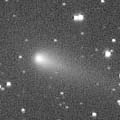
|
Although it had been strongly condensed until early January, it became diffused since late January. It is fading gradually, around 11.5 mag in January and around 12.5 mag in February. It was still bright at 12.6 mag on Mar. 8 (Seiichi Yoshida). Although the brightening evolution before the perihelion passage was extremely rapid, the fading after the perihelion passage is slow as expected. It will be visible visually until May when it becomes too low in the evening sky at 13-14 mag.
Date(TT) R.A. (2000) Decl. Delta r Elong. m1 Best Time(A, h)
Mar. 5 4 25.54 15 46.5 2.160 2.261 82 12.4 19:22 ( 59, 59)
Mar. 12 4 37.23 16 17.8 2.264 2.287 78 12.6 19:28 ( 66, 55)
|

|
Michael Jager succeeded to observe the component A in the extremely low sky at dusk on Feb. 27. It was 12.0 mag, almost as bright as expected. Note that the actual position is somewhat off from the prediction. Reinder J. Bouma calculated that the actual perihelion passage is Feb. 28.246. The component D has not been detected yet. The The condition of this appearance is bad. In the Northern Hemisphere, it becomes highest in April, but only 19 deg high. It will keep 12 mag in March, but it will fade out very rapidly after April. In the Southeren Hemisphere, the condition is worse. It will appear in the evening low sky after late March.
Date(TT) R.A. (2000) Decl. Delta r Elong. m1 Best Time(A, h)
Mar. 5 0 35.92 6 17.5 1.506 0.758 26 12.5 19:22 ( 92, 8)
Mar. 12 1 15.60 8 52.3 1.477 0.781 29 12.4 19:28 ( 93, 11)
|
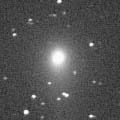
|
Although it had been rather large and easy to see until February, it became small as 1 arcmin, and the condensation became weak in early March. But it is still visible at 12.5 mag. In the Northern Hemisphere, it keeps the same altitude at 35 deg high in the evening sky until June when it fades down to 15 mag.
Date(TT) R.A. (2000) Decl. Delta r Elong. m1 Best Time(A, h)
Mar. 5 1 1.33 60 9.5 2.433 2.297 70 12.5 19:22 (143, 36)
Mar. 12 1 21.43 62 4.0 2.500 2.335 68 12.7 19:28 (146, 34)
|

|
It has been small at 12.5-13.0 mag since November. It keeps observable with the same appearance and brightness in the evening sky until May.
Date(TT) R.A. (2000) Decl. Delta r Elong. m1 Best Time(A, h)
Mar. 5 3 48.19 27 10.8 1.813 1.852 76 12.6 19:22 ( 86, 58)
Mar. 12 4 3.96 28 19.4 1.866 1.843 73 12.6 19:28 ( 91, 55)
|

|
It passes the perihelion in early March and becomes bright as 12 mag. However it is not observable because too close to the sun. It was the best chance to observe it in last December and some observation campaigns were operated. However, no coma was detected.
Date(TT) R.A. (2000) Decl. Delta r Elong. m1 Best Time(A, h)
Mar. 5 22 30.30 -8 19.4 1.080 0.174 8 12.7 5:00 (272,-13)
Mar. 12 23 4.31 0 16.6 1.341 0.375 7 13.8 4:51 (262,-11)
|
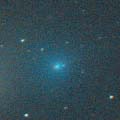
|
It has been large and extremely diffused visually. It was bright and large in early January, 11 mag and 2-5 arcmin, however, it became much fainter and smaller in early February, 12.5 mag and 1.5 arcmin. It became fainter and smaller further more on Mar. 8, 13.3 mag and 0.8 arcmin (Seiichi Yoshida).
Date(TT) R.A. (2000) Decl. Delta r Elong. m1 Best Time(A, h)
Mar. 5 12 48.90 19 11.4 0.810 1.745 151 12.8 1:59 ( 0, 74)
Mar. 12 12 44.28 19 55.2 0.831 1.782 155 13.1 1:27 ( 0, 75)
|

|
It brightened rapidly in January and reached to 13 mag. It is 12.8 mag, small as 0.9 arcmin, and unexpectedly rather well condensed (Mar. 8, Seiichi Yoshida). It will keep bright at 13 mag in the evening sky until April.
Date(TT) R.A. (2000) Decl. Delta r Elong. m1 Best Time(A, h)
Mar. 5 3 42.57 12 10.3 1.305 1.372 71 13.0 19:22 ( 66, 49)
Mar. 12 4 4.72 15 10.3 1.339 1.380 70 13.0 19:28 ( 72, 49)
|

|
It will be at opposition and reach to 13.5 mag in March and April. Due to the retrograde orbit, it moves very fast from the morning sky to the evening sky, and immediately becomes unobservable. Recent CCD observations are a bit fainter than this ephemeris, 15 mag still in late February. This suggests that it may reach to 14 mag at best. In the Northern Hemisphere, it locates very low in the south, so it may be impossible to see it visually.
Date(TT) R.A. (2000) Decl. Delta r Elong. m1 Best Time(A, h)
Mar. 5 13 56.08 -38 3.5 1.384 2.069 120 13.9 3:07 ( 0, 17)
Mar. 12 13 12.12 -38 20.3 1.258 2.059 131 13.6 1:56 ( 0, 17)
|

|
It had been always brighter than 13 mag and visible visually all through the season in 2004. However, it has been rather faint, diffused, and hard to see since mid January. It is already very low in the evening sky. It is not observable from March to May. It will appear at dawn again in June.
Date(TT) R.A. (2000) Decl. Delta r Elong. m1 Best Time(A, h)
Mar. 5 0 39.19 12 22.5 6.569 5.735 30 13.8 19:22 ( 97, 12)
Mar. 12 0 44.43 12 53.5 6.621 5.735 24 13.8 19:28 (101, 7)
|

|
It keeps bright as 12-13 mag visually since last November. It is diffused as DC=2, but bright as 12.0 mag with a diameter of 0.9 arcmin still now (Feb. 5, Seiichi Yoshida). However, it has been fading on and on by CCD observations. It was so faint as 15.9 mag in late February by CCD (Feb. 27, Akimasa Nakamura). The difference between visual and CCD observations is extremely large. It keeps observable for a long time after this in the Northern Hemisphere. It is also visible in the morning low sky.
Date(TT) R.A. (2000) Decl. Delta r Elong. m1 Best Time(A, h)
Mar. 5 23 51.93 54 23.4 4.490 4.108 61 14.1 19:22 (140, 25)
Mar. 12 0 3.45 54 14.1 4.621 4.181 58 14.2 19:28 (142, 22)
|

|
It was 18.5 mag still in mid January. The brightening is slower than expected. The ephemeris says it will brighten rapidly after this, and reach to 8 mag from July to August. However, it is not observable for a while. In the Northern Hemisphere, it will appear at dawn at 11.5 mag in late May, then it keeps observable for a long time after that. In the Southern Hemisphere, it only appears in the morning very low sky from late April to mid June, but not observable when the comet is bright.
Date(TT) R.A. (2000) Decl. Delta r Elong. m1 Best Time(A, h)
Mar. 5 0 19.20 -17 52.9 2.795 1.913 22 14.9 19:22 ( 75, -9)
Mar. 12 0 23.52 -14 51.3 2.771 1.850 17 14.7 19:28 ( 81,-13)
|

|
It will reach to 10 mag in June and July. It keeps locating rather low in the morning until that. It was 16.0 mag on Mar. 9, brightening almost as expected. It tends to be brighter before the perihelion passage. It will become visible visually at 13 mag in April.
Date(TT) R.A. (2000) Decl. Delta r Elong. m1 Best Time(A, h)
Mar. 5 19 44.72 3 32.4 2.322 1.854 50 15.2 5:00 (286, 28)
Mar. 12 20 3.14 4 59.2 2.222 1.790 51 14.8 4:51 (285, 29)
|
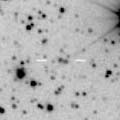
|
It brightened from 18 to 15 mag during one year from the end of 2003 to early 2005. The brightness evolution was much faster than that of a typical comet. It will become too low in the evening at 14.5 mag in June. Then it can be 13 mag and may be visible visually in next winter.
Date(TT) R.A. (2000) Decl. Delta r Elong. m1 Best Time(A, h)
Mar. 5 5 23.28 47 31.5 5.776 5.995 97 14.9 19:22 (146, 74)
Mar. 12 5 25.70 47 20.7 5.851 5.969 92 14.9 19:28 (135, 70)
|
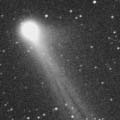
|
Fading gradually as predicted. It had been visible visually at 14 mag until January. But it became too faint to see visually after February. It will be 17 mag in June.
Date(TT) R.A. (2000) Decl. Delta r Elong. m1 Best Time(A, h)
Mar. 5 10 2.79 -11 51.2 3.643 4.571 156 14.9 23:08 ( 0, 43)
Mar. 12 9 54.76 -10 44.7 3.739 4.645 152 15.0 22:33 ( 0, 44)
|

|
It will reach to 9 mag in 2006 spring. In the Southern Hemisphere, it keeps observable until that. In the Northern Hemisphere, it will be too low in the evening in March. Then it keeps unobservable until 2006 March, except it appears very low in the morning at 12 mag from late August to early September. After 2006 March, northern people can observe it for a long time while it is getting fainter. It has been brightening well as expected until early 2005.
Date(TT) R.A. (2000) Decl. Delta r Elong. m1 Best Time(A, h)
Mar. 5 4 8.38 -16 48.5 4.468 4.324 75 15.1 19:22 ( 36, 30)
Mar. 12 4 7.82 -16 24.2 4.500 4.259 69 15.1 19:28 ( 44, 26)
|

|
It reached to 13 mag and was observed visually in good condition in 2004 autumn. Then it has been fading on and on while being apart from the earth. It will be low in the evening sky at 16.5 mag in August.
Date(TT) R.A. (2000) Decl. Delta r Elong. m1 Best Time(A, h)
Mar. 5 2 19.72 57 39.0 2.006 1.996 75 15.1 19:22 (140, 46)
Mar. 12 2 44.92 58 49.1 2.059 2.012 73 15.1 19:28 (141, 44)
|

|
Peculiar comet which becomes brightest about 5 months after the perihelion passage. It became brightest in February, about 5 months after the perihelion passage, as expected. However, it is fainter than expected in this return, and reaches to 15.5 mag at best. It was not visible visually, fainter than 14.0 mag (Feb. 5, Seiichi Yoshida).
Date(TT) R.A. (2000) Decl. Delta r Elong. m1 Best Time(A, h)
Mar. 5 10 14.28 33 4.2 1.964 2.871 150 15.5 23:20 ( 0, 88)
Mar. 12 10 10.14 33 24.6 2.017 2.887 144 15.6 22:48 ( 0, 88)
|

|
New bright periodic comet discovered in 2004 spring. In last year, it had been bright at 15.0-15.5 mag from spring to summer. In this year, it is expected to be as bright as last year from spring to autumn. The ephemeris says it keeps brighter than 19 mag even around the aphelion, however, the comet had not been discovered before 2004. This suggests the comet became bright temporarily last year. If so, it can be much fainter than this ephemeris now.
Date(TT) R.A. (2000) Decl. Delta r Elong. m1 Best Time(A, h)
Mar. 5 19 8.29 -24 54.4 3.265 2.882 59 15.7 5:00 (315, 14)
Mar. 12 19 18.83 -25 3.7 3.187 2.887 63 15.6 4:51 (316, 15)
|

|
Appearing at dawn and observed after a long time. Because there is a large difference among reported observations in 2004, the true brightness was uncertain. Actually, it was 16.0 mag (Feb. 11, Ken-ichi Kadota). It will be observable in good condition at 15 mag from April to June.
Date(TT) R.A. (2000) Decl. Delta r Elong. m1 Best Time(A, h)
Mar. 5 18 14.76 0 10.4 3.761 3.583 72 15.9 5:00 (308, 42)
Mar. 12 18 12.07 1 14.9 3.613 3.563 79 15.8 4:51 (313, 46)
|
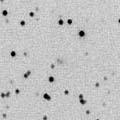
|
It came closer to the earth and reached to 15.5-16 mag by CCD observations. It looked diffused on the CCD images. So it was also visible visually at 14.3 mag (Feb. 6, Reinder J. Bouma). However, it will be getting apart from the earth after this, and getting fainter on and on.
Date(TT) R.A. (2000) Decl. Delta r Elong. m1 Best Time(A, h)
Mar. 5 7 58.92 49 28.1 1.225 1.942 122 15.8 21:06 (180, 76)
Mar. 12 8 6.83 46 49.0 1.263 1.945 118 15.9 20:46 (180, 78)
|

|
It brightened rapidly from 19 to 17 mag in early 2004. But it is in normal state now, 16.5 mag in early 2005. It keeps 15-16 mag for a long time until early 2007.
Date(TT) R.A. (2000) Decl. Delta r Elong. m1 Best Time(A, h)
Mar. 5 16 1.66 -18 16.4 2.986 3.343 102 16.0 5:00 (357, 37)
Mar. 12 16 4.77 -18 32.9 2.876 3.330 108 15.9 4:46 ( 0, 36)
|

|
It has been brightening rapidly as expected, 19 mag in January and 17 mag in February. It keeps visible as bright as 12-13 mag for a long time from May to September. The condition is good in the Southern Hemisphere, but it locates very low in the Northern Hemisphere. In the previous return, it was 1.5 mag brighter than this ephemeris visually. So it can be around 11.0 mag visually at best in this return, too.
Date(TT) R.A. (2000) Decl. Delta r Elong. m1 Best Time(A, h)
Mar. 5 15 22.10 -30 25.1 1.594 2.123 108 16.6 4:31 ( 0, 25)
Mar. 12 15 30.65 -31 40.3 1.486 2.083 112 16.2 4:12 ( 0, 23)
|

|
It has been fading rather faster than usual since the perihelion passage in 2004 spring. It will be observable in good condition until May when it becomes fainter than 18 mag.
Date(TT) R.A. (2000) Decl. Delta r Elong. m1 Best Time(A, h)
Mar. 5 10 19.41 42 12.5 3.236 4.070 142 16.4 23:25 (180, 83)
Mar. 12 10 11.39 41 34.6 3.344 4.137 138 16.6 22:49 (180, 84)
|
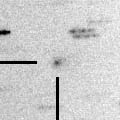
|
In its last return in 1997, it burst out after the perihelion passage and became extremely bright, reached to 11 mag. However, it is faint in this return. It has already passed the perihelion on Nov. 30, but it had been constant at 15.5 mag from November to January. Because this comet tends to brighten and fade very rapidly, it will fade out rapidly after March while being apart from the earth, and will be fainter than 18 mag in April.
Date(TT) R.A. (2000) Decl. Delta r Elong. m1 Best Time(A, h)
Mar. 5 8 47.03 38 9.6 1.267 2.094 135 16.6 21:53 (180, 87)
Mar. 12 8 48.35 38 25.8 1.341 2.116 129 16.9 21:27 (180, 87)
|

|
It brightened suddenly in outburst from 17.5 to 14 mag in late November. In December and January, around the perihelion passage, it was visible visually at 13.5 mag. However, it began to fade out rapidly in mid January. It was already too faint to see visually, fainter than 14.0 mag, on Feb. 6 (Reinder J. Bouma). It was so faint as 16.2 mag even by the CCD observation on Feb. 27 (Akimasa Nakamura).
Date(TT) R.A. (2000) Decl. Delta r Elong. m1 Best Time(A, h)
Mar. 5 2 41.66 49 29.8 2.933 2.809 73 16.8 19:22 (128, 49)
Mar. 12 2 39.04 49 3.0 3.076 2.833 66 17.1 19:28 (127, 43)
|
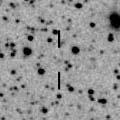
|
It keeps 15.4 mag until May when it becomes low in the evening. It will be observable again in 2006 spring, but it will be fainter than now by 1 mag.
Date(TT) R.A. (2000) Decl. Delta r Elong. m1 Best Time(A, h)
Mar. 5 5 33.33 25 12.4 2.508 2.846 99 16.8 19:22 ( 45, 77)
Mar. 12 5 38.95 25 2.8 2.596 2.840 93 16.8 19:28 ( 61, 72)
|

|
Recovery of a peculiar asteroid 2004 FS101 discovered in 2004 spring. It keeps observable at 15-16 mag for a long time from 2005 spring to 2006 winter. Because it moves in the northern sky, it keeps observable for a long time in the Northern Hemisphere.
Date(TT) R.A. (2000) Decl. Delta r Elong. m1 Best Time(A, h)
Mar. 5 14 35.70 31 7.7 3.963 4.596 124 17.1 3:45 ( 0, 86)
Mar. 12 14 33.65 33 17.6 3.878 4.552 127 17.0 3:15 ( 0, 88)
|

|
Because it moves in the northern sky, it keeps observable for a long time in the Northern Hemisphere. The brightening in latter 2004 was rather faster than usual, however, it will reach to only 16 mag at best in early 2006.
Date(TT) R.A. (2000) Decl. Delta r Elong. m1 Best Time(A, h)
Mar. 5 4 54.36 48 11.5 5.478 5.621 93 17.2 19:22 (138, 70)
Mar. 12 4 56.94 48 11.6 5.555 5.597 87 17.2 19:28 (131, 65)
|
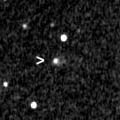
|
It kept 16.5 mag in December and January. But it will fade out after that, and will be fainter than 18 mag in April.
Date(TT) R.A. (2000) Decl. Delta r Elong. m1 Best Time(A, h)
Mar. 5 10 25.81 33 35.5 1.876 2.786 151 17.3 23:31 ( 0, 89)
Mar. 12 10 19.98 33 46.4 1.950 2.827 145 17.5 22:58 ( 0, 89)
|
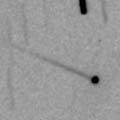
|
Fading slowly along with a magnitude formula as an asteroid of H=13.7 mag. It keeps observable in good condition until April when it becomes fainter than 18 mag. Almost stellar, so it must be easy to detect even if so faint.
Date(TT) R.A. (2000) Decl. Delta r Elong. m1 Best Time(A, h)
Mar. 5 3 52.24 51 41.2 1.581 1.778 84 17.4 19:22 (135, 60)
Mar. 12 4 18.40 51 52.2 1.680 1.829 81 17.5 19:28 (134, 59)
|
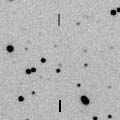
|
It keeps 17.5 mag until May when it becomes low in the evening sky. It will be observable again in 2006, then it will be brighter by 1 mag.
Date(TT) R.A. (2000) Decl. Delta r Elong. m1 Best Time(A, h)
Mar. 5 3 45.81 22 56.2 2.848 2.762 74 17.4 19:22 ( 80, 56)
Mar. 12 3 53.74 23 48.3 2.913 2.736 69 17.4 19:28 ( 86, 51)
|

|
Split comets. It is observable in good condition at 17.5 mag until March. The component B is fainter than A by 0.6 mag.
Date(TT) R.A. (2000) Decl. Delta r Elong. m1 Best Time(A, h)
Mar. 5 9 12.42 41 4.2 3.631 4.411 137 17.5 22:18 (180, 84)
Mar. 12 9 9.73 40 48.8 3.692 4.411 131 17.6 21:48 (180, 84)
|

|
Althouhg it is a far object, it only becomes brighter than 18 mag from February to May.
Date(TT) R.A. (2000) Decl. Delta r Elong. m1 Best Time(A, h)
Mar. 5 10 48.13 -1 22.9 3.501 4.485 171 17.7 23:53 ( 0, 54)
Mar. 12 10 39.60 -1 53.0 3.502 4.474 166 17.7 23:17 ( 0, 53)
|

|
Because it is a far object, it has been observed at 17.5 mag for one and a half year since 2003 summer. It has already passed the perihelion, so it will become a bit fainter this year. But it keeps 18 mag until summer.
Date(TT) R.A. (2000) Decl. Delta r Elong. m1 Best Time(A, h)
Mar. 5 16 37.03 38 52.3 7.007 7.226 98 17.8 5:00 (244, 80)
Mar. 12 16 33.78 39 43.5 6.958 7.241 102 17.8 4:51 (224, 83)
|

|
Because it is a far object, it has been observed almost 4 years since 2001 summer. It had been observed at 17 mag for more than 1 year from 2003 summer to 2004 summer. It has already passed the perihelion, and it became a bit fainter in early 2005 as 17.7 mag. It will be faintr than 18 mag in spring.
Date(TT) R.A. (2000) Decl. Delta r Elong. m1 Best Time(A, h)
Mar. 5 13 34.12 52 6.1 6.245 6.855 124 17.8 2:44 (180, 73)
Mar. 12 13 25.05 52 46.0 6.262 6.882 125 17.9 2:07 (180, 72)
|
|
![]()
 29P/Schwassmann-Wachmann 1
29P/Schwassmann-Wachmann 1 C/2001 Q4 ( NEAT )
C/2001 Q4 ( NEAT ) 161P/2004 V2 ( Hartley-IRAS )
161P/2004 V2 ( Hartley-IRAS ) 21P/Giacobini-Zinner
21P/Giacobini-Zinner C/2003 WT42 ( LINEAR )
C/2003 WT42 ( LINEAR ) C/2002 T7 ( LINEAR )
C/2002 T7 ( LINEAR ) C/2004 B1 ( LINEAR )
C/2004 B1 ( LINEAR ) (944) Hidalgo
(944) Hidalgo 121P/Shoemaker-Holt 2
121P/Shoemaker-Holt 2 P/2004 F3 ( NEAT )
P/2004 F3 ( NEAT ) C/2004 K1 ( Catalina )
C/2004 K1 ( Catalina ) C/2004 RG113 ( LINEAR )
C/2004 RG113 ( LINEAR ) 117P/Helin-Roman-Alu 1
117P/Helin-Roman-Alu 1 37P/Forbes
37P/Forbes C/2003 T3 ( Tabur )
C/2003 T3 ( Tabur ) 69P/Taylor
69P/Taylor C/2004 U1 ( LINEAR )
C/2004 U1 ( LINEAR ) 129P/Shoemaker-Levy 3
129P/Shoemaker-Levy 3 C/2005 B1 ( Christensen )
C/2005 B1 ( Christensen ) C/2004 D1 ( NEAT )
C/2004 D1 ( NEAT ) 164P/2004 Y1 ( Christensen )
164P/2004 Y1 ( Christensen ) 162P/2004 TU12 ( Siding Spring )
162P/2004 TU12 ( Siding Spring ) P/2004 VR8 ( LONEOS )
P/2004 VR8 ( LONEOS ) P/2004 V5 ( LINEAR-Hill )
P/2004 V5 ( LINEAR-Hill ) C/2004 X3 ( LINEAR )
C/2004 X3 ( LINEAR ) C/2003 O1 ( LINEAR )
C/2003 O1 ( LINEAR ) C/2002 J5 ( LINEAR )
C/2002 J5 ( LINEAR )![]()



























